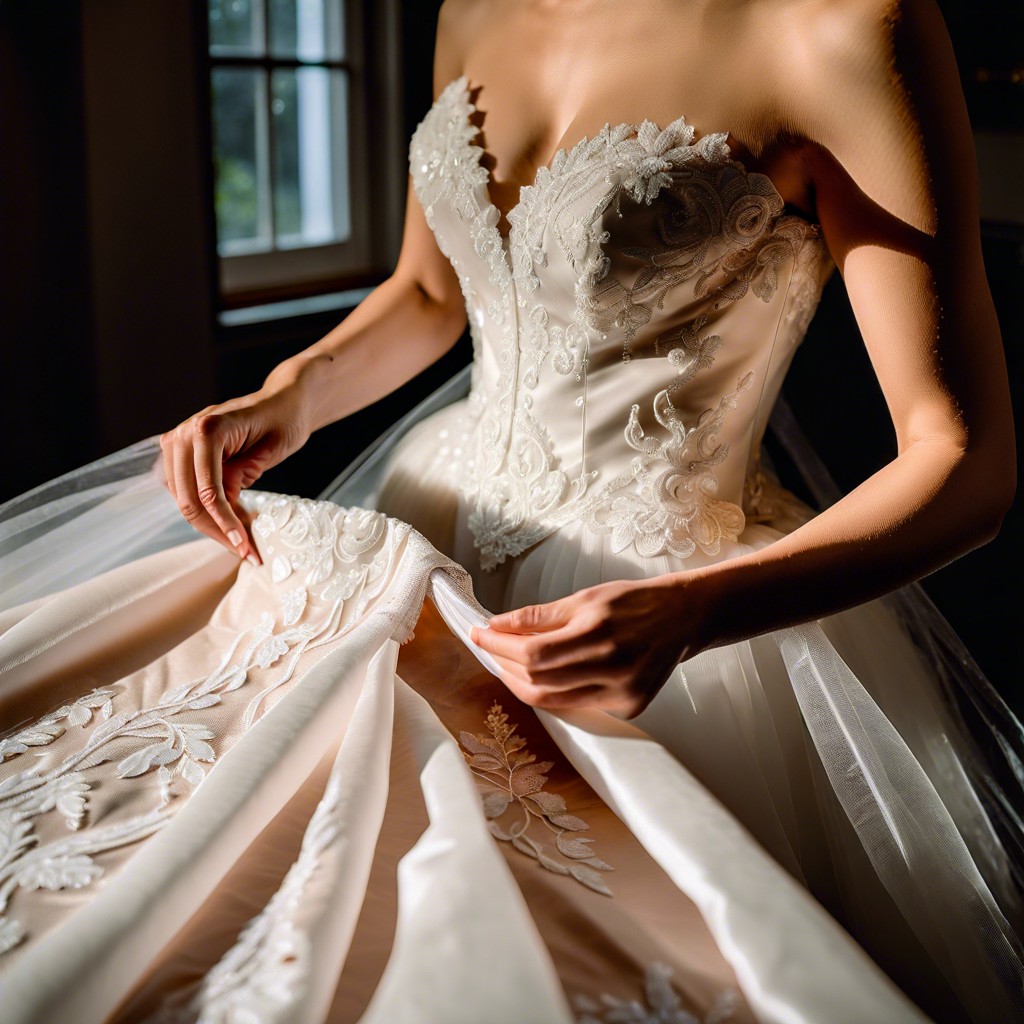Learn how to preserve your wedding dress to maintain its beauty for years to come.
Key takeaways:
- Preserve your wedding dress to maintain its beauty and integrity.
- Meticulously clean and wrap your gown to prevent yellowing and fabric deterioration.
- Choose a professional preservationist with a proven track record and safe cleaning methods.
- Preservation costs vary based on factors such as dress complexity and materials used.
- Store your preserved dress in a cool, dark place and periodically inspect it.
Why Wedding Dress Preservation Is Essential

Preserving your wedding dress serves as a safeguard against degradation over time. Fabrics are prone to yellowing, and delicate embellishments may deteriorate if they aren’t properly cared for. By preserving your dress, you are taking steps to maintain its beauty and integrity for years to come.
Another compelling reason to preserve your gown is to retain its sentimental value. For many, a wedding dress is more than just fabric and lace; it’s laden with memories and emotions. Ensuring that your dress is meticulously preserved means you can revisit those cherished moments and even share them with future generations.
Furthermore, a well-preserved gown might have heirloom potential. It could be worn or repurposed by loved ones, creating new memories while honoring past traditions. Whether keeping it within the family or considering future utilization, preservation makes sure your dress continues to tell a story long after the big day.
The Preservation Process Step-by-Step
After the joyous wedding festivities, preserving your wedding dress ensures it remains a cherished keepsake. The step-by-step process generally involves a few key stages:
Firstly, expert cleaners will carefully examine your gown to identify any stains or spots. The type of fabric and the nature of the stains (such as grass, wine, or makeup) will dictate the cleaning methods used.
Secondly, specialized cleaning techniques are used to treat and remove these blemishes. This may include gentle hand washing or advanced solvent-based cleaning which is safe for delicate fabrics and intricate details.
Once the dress is immaculately cleaned, it’s time for the actual preservation. The gown is usually wrapped in acid-free tissue paper and placed in a museum-quality archival box, which helps prevent yellowing and fabric deterioration.
It’s important to note that the box should be kept in a cool, dark, and dry environment to maintain the dress’s condition. Avoid storing the box in basements or attics where temperatures and humidity can fluctuate drastically.
Throughout the process, be sure to communicate any special requests or concerns to your preservationist. They are there to ensure your gown is protected and preserved for future generations to admire.
Choosing a Professional Preservationist
Selecting the right expert to handle your dress is crucial. Look for a preservationist with a proven track record, ideally specializing in wedding dresses. Check for reviews and testimonials from other couples to gauge satisfaction levels.
Inquire about the methods used, ensuring they are safe for your specific fabric and embellishments. Avoid general dry-cleaners; a specialist should perform this delicate task. Ask about the type of cleaning solvents used and ensure they opt for gentle, environmentally safe options if that aligns with your preferences.
Clarify what is included in their service. Do they offer pre-preservation consultation to discuss stains and potential issues? Will they allow you to inspect the dress post-cleaning and before preservation?
Review their guarantee policy. A reliable preservationist should stand behind the quality of their work and offer a guarantee that protects against yellowing or fabric degradation.
Lastly, consider their turnaround time and convenience. Some may offer pickup and delivery services, which can be useful if you’re managing a busy post-wedding schedule.
Understanding Preservation Costs
Preservation costs vary based on several factors such as the complexity of the dress design, the materials used, and the level of soiling. Typically, prices start around $150 and can go up to $500 or more for luxury gowns. Special treatments, like removing tough stains or repairing damages, may add to the cost.
It’s crucial to receive a detailed quote before committing to a preservation service. Some companies offer packages that include cleaning, preservation, and a guarantee. Always clarify what’s included in the price to avoid unexpected fees.
Comparing different preservationists can help you find a service that fits your budget while still providing quality care. Remember, preserving your wedding dress is an investment to maintain its beauty and longevity, potentially transforming it into a cherished family heirloom.
Long-Term Care Recommendations
Storing your preserved dress in a cool, dark place helps prevent any light-induced yellowing. Ideally, choose a location with consistent temperatures to avoid materials deteriorating due to heat or humidity fluctuations.
Avoid storing the dress in a basement or attic where environmental conditions can be unpredictable. Instead, opt for a closet or under the bed within your living space, where the climate feels comfortable year-round.
Periodically inspect your dress, preferably once a year, to ensure it’s maintaining its condition. Handle it with clean, dry hands or white cotton gloves to avoid transferring oils or dirt onto the fabric.
Resist the temptation to remove the dress from its preservation box frequently. The more it’s handled, the more likely it is to suffer damage. If you do need to remove it, ensure it’s refolded differently to avoid permanent creases forming on the fabric.
Keep the dress away from harsh chemicals and pollutants such as smoke or cooking fumes, as these can permeate the fabric and cause deterioration or odors.



